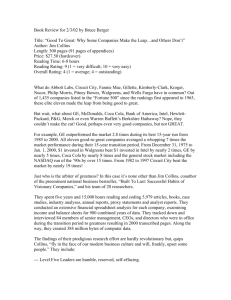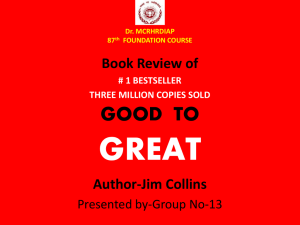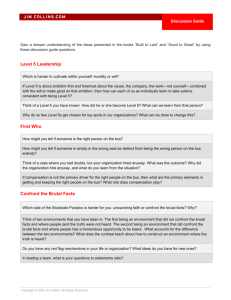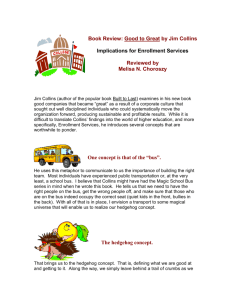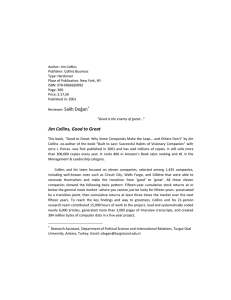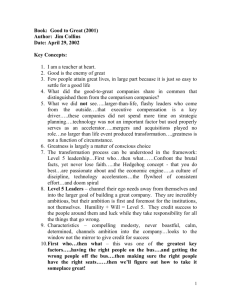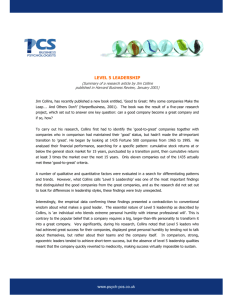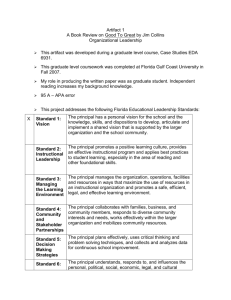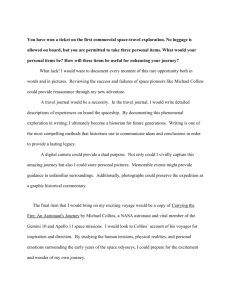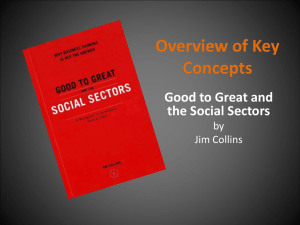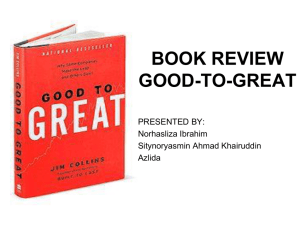Good to Great - Altfeld Inc.
advertisement
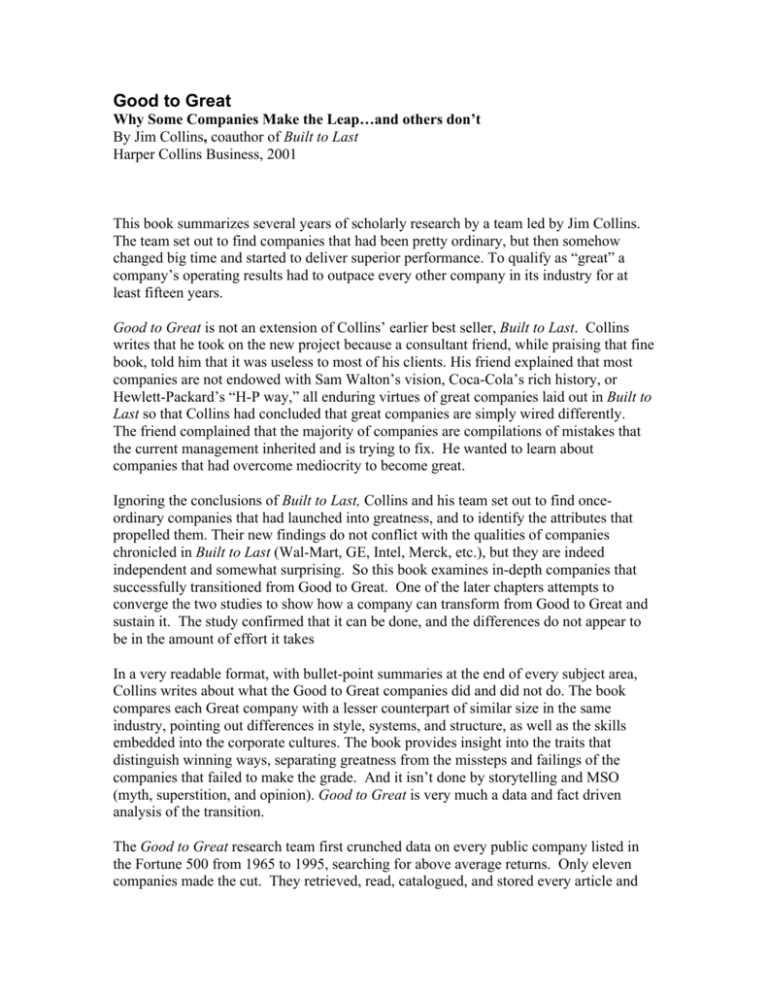
Good to Great Why Some Companies Make the Leap…and others don’t By Jim Collins, coauthor of Built to Last Harper Collins Business, 2001 This book summarizes several years of scholarly research by a team led by Jim Collins. The team set out to find companies that had been pretty ordinary, but then somehow changed big time and started to deliver superior performance. To qualify as “great” a company’s operating results had to outpace every other company in its industry for at least fifteen years. Good to Great is not an extension of Collins’ earlier best seller, Built to Last. Collins writes that he took on the new project because a consultant friend, while praising that fine book, told him that it was useless to most of his clients. His friend explained that most companies are not endowed with Sam Walton’s vision, Coca-Cola’s rich history, or Hewlett-Packard’s “H-P way,” all enduring virtues of great companies laid out in Built to Last so that Collins had concluded that great companies are simply wired differently. The friend complained that the majority of companies are compilations of mistakes that the current management inherited and is trying to fix. He wanted to learn about companies that had overcome mediocrity to become great. Ignoring the conclusions of Built to Last, Collins and his team set out to find onceordinary companies that had launched into greatness, and to identify the attributes that propelled them. Their new findings do not conflict with the qualities of companies chronicled in Built to Last (Wal-Mart, GE, Intel, Merck, etc.), but they are indeed independent and somewhat surprising. So this book examines in-depth companies that successfully transitioned from Good to Great. One of the later chapters attempts to converge the two studies to show how a company can transform from Good to Great and sustain it. The study confirmed that it can be done, and the differences do not appear to be in the amount of effort it takes In a very readable format, with bullet-point summaries at the end of every subject area, Collins writes about what the Good to Great companies did and did not do. The book compares each Great company with a lesser counterpart of similar size in the same industry, pointing out differences in style, systems, and structure, as well as the skills embedded into the corporate cultures. The book provides insight into the traits that distinguish winning ways, separating greatness from the missteps and failings of the companies that failed to make the grade. And it isn’t done by storytelling and MSO (myth, superstition, and opinion). Good to Great is very much a data and fact driven analysis of the transition. The Good to Great research team first crunched data on every public company listed in the Fortune 500 from 1965 to 1995, searching for above average returns. Only eleven companies made the cut. They retrieved, read, catalogued, and stored every article and newspaper account of these companies. Then they interviewed executives and managers from the companies using standard questionnaires to draw out policy and anecdotal information. Finally, the twenty-one-person team spent hours dialoguing with each other in order to validate all conclusions based on the relevant information. The book shows the thoroughness of the effort. Conclusions are presented with data, relevant anecdotes, very little hoopla, and no hype. The eleven Good to Great companies had to pass rigorous screening. Being lucky didn’t matter. Each had been good for a number of years before launching into greatness – breakthrough, better-than-the-industry performance sustained for at least 15 years. Cumulative returns had to out-perform the industry and business in general by better by three times or more. This is a tough test. A marquis mutual fund comprised of 3M, Boeing, Coca-Cola, GE, Hewlett Packard, Intel, Johnson & Johnson, Merck, Motorola, Pepsi, Proctor & Gamble, Wal-Mart, and Walt Disney only outperformed the industry average by 2.5 times. Not good enough. A section labeled “dogs that did not bark” reveals some surprises about traits missing in the eleven: No “larger-than-life celebrity figures”, launch events, tag line names, or programs, and no specific attention to “managing change,” to name a few. These tidbits make one want to dig into the appendix for the research notes as I did. Collins style brings out the human side of the organizations. For example, a telling comment is, “that good is the enemy of great is not just a business problem, it is a human problem.” The team obviously had some surprise discoveries just as the reader will about transformations to greatness. So, exactly what differences are found in those companies that go from good to great? Attribute number one is great Leadership. Each of the good to great companies exhibited Level 5 Leadership, which isn’t what most would expect. Level 5 Leadership is humility + will, devoid of ego but not ambition. The ambition is for the organization’s success more than personal recognition. A whole chapter describes level 5 Leadership in some detail. Once you read about it, it is immediately familiar, but far from anything popularized in common stereotypes about how to transform an ailing company. Level 5 Leadership cannot be imitated; it must be inbred for real. A senior manager cannot begin practicing Level 5 Leadership and expect immediate results. But with steady leadership, and regular practice of the other six attributes found in all the good to great companies, a level 4 leader (a Jack Welch type) might emerge into a level 5 leader. Many readers may idealize level 4 leadership. A level 4 leader catalyzes commitment, initiates vigorous pursuit of a clear compelling vision, and then stimulates higher performance standards, but that’s labeled only as “effective leadership.” The research shows that level 4 cannot sustain company greatness. Eleven out of eleven Good to Great company examples, along with a number of references to level 4 leader false starts and burn-outs will help to convince you otherwise. A chapter is devoted to each of the next six actionable attributes: 1) First Who… Then What; 2) Confront the Brutal Facts (Yet never Lose Faith); 3) The Hedgehog Concept (Simplicity within Three Circles); 4) A Culture of Discipline; 5) Technology Accelerators; and 6) The Flywheel and the Doom Loop. Everyone who has gotten frustrated at an organization will appreciate every one of these attributes. First Who…Then What uses the analogy of getting the right people on the bus (and the wrong ones off) before deciding where the bus is going. The bus analogy is powerful because it is so true to form. Deciding on actions before assembling the team regularly fails because teams struggle implementing solutions that they may not completely understand or buy into. When teams are assembled first and challenged to solve most problems, they take ownership, succeed, or keep trying until they do. Confronting the Brutal Facts describes the Stockdale Paradox about surviving under wretched conditions without ever giving up hope, a powerful reinforcement of the value of determination under pressure. Examples here are replete with happy endings. The Hedgehog Concept uses another analogy, a battle between the cunning fox and the small-brained hedgehog. The fox is brilliant in strategy, fanciful in tactics, and exceptional in response and resilience. The hedgehog knows only one simple but effective tactic for survival, but knows it and executes it very, very well. Having a crystal clear notion about what one can be the best in the world at; what drives the economic engine (the denominator); and how to focus on what you are deeply passionate about is the critical do-loop of the hedgehog concept. The Technology Accelerator means that Good to Great companies think of technology as a means to something else, never as a goal in and of itself. Good to Greats are never first into a technology initiative, but rarely last to adopt it either. This goes for other initiatives as well. Not one of the eleven is an acclaimed lean or JIT legend. Don’t be disillusioned though; the Good to Greats do a lot of lean things in the course of doing business. Their transition is simply not marked or dominated by any one practice or theme, not lean methodology, nor any other popular best practice. These companies don’t exhibit zeal for any one thing they do, they do a lot of things well. The sixth attribute, much understated in this reader’s opinion, is A Culture of Discipline in thought, people, and execution. A culture for it is surely the missing and most elusive attribute in many companies attempting to become great. And while no lean legends were included in the eleven good to great finalists (mostly screened out due to insufficient longevity or not being a public company), the culture of discipline described is the one most of us would credit for lean success. The last attribute, the Flywheel and the Doom Loop, is all about persistence. That Good to Great companies don’t get wrapped up in single initiatives is another aspect of collaborative company discipline. Strategic single mindedness and continuity in managerial succession gives ideas a chance to materialize before injecting new ones. Good to great companies lack visible excitement around themes, publicized reversals, or restructurings. Neither do they have program-driven defining events or magic moments. They move the flywheel slowly at first, because it needs to overcome inertia. Once an idea they are acting on begins to gain momentum, it still doesn’t move swiftly. But then like the flywheel, once moving there is no stopping. No great leaps forward, but also, no obvious setbacks. The Good to Greats credit no great programs for their success. These merely accumulate so that all the programs look tiny and the outcome simply is great. So, who are these Good to Great companies? Alphabetically in order: Abbott, Circuit City, Fannie Mae, Gillette, Kimberly Clark, Kroger, Nucor, Phillip Morris, Pitney Bowes, Walgreen’s, and Wells Fargo. Companies consistently out performing the cumulative returns of all other companies in the market by as much as 18.5 times, and no less than 3.4 times for a contiguous fifteen-year period between 1972 and 1999. Some have fallen from grace in recent times but still deliver total returns to investors of 11% to 23% for the ten years 1991-2001. High flyers? High techs? Dot coms? Not exactly! Known to AME via workshops, Abbott, Gillette, Nucor, and Pitney Bowes are hard-core product makers, grind-it-out organizations that make stuff and execute their value creation propositions very well. Read this book if you aspire to greatness without hyperbole. Ken McGuire is an internationally recognized Management Consultant for Operations and Manufacturing with the firm Management Excellence Action Coalition(MEAC). Ken has produced many educational programs for AME from its beginning. He served as a member of AME’s Corporate Board 1992 1998, Co-Chaired the 1997 San Antonio and 2000 Boston AME Annual Conferences and is a founding member of its Northeast Region.
